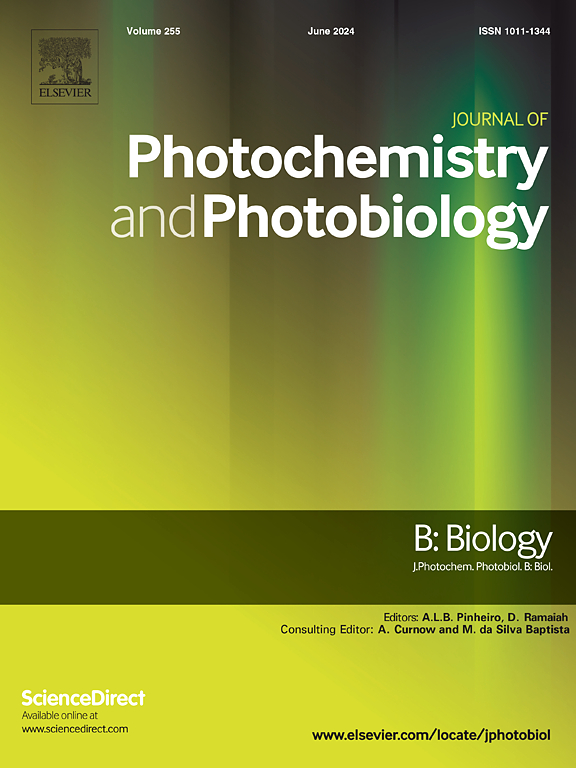鼻内纳米光敏剂可实现安全、广谱的呼吸道病毒光动力灭活。
IF 3.7
2区 生物学
Q2 BIOCHEMISTRY & MOLECULAR BIOLOGY
Journal of photochemistry and photobiology. B, Biology
Pub Date : 2025-09-04
DOI:10.1016/j.jphotobiol.2025.113261
引用次数: 0
摘要
包括SARS-CoV-2及其变种在内的高传染性呼吸道病毒的出现,强调了迫切需要安全、变异不可知和自我给药的抗病毒策略。在这里,我们提出了一种基于亚甲基蓝纳米粒子的纳米治疗平台(MBSD),该纳米治疗平台由天然存在于人鼻粘膜的一种初级脂肪酸稳定,设计用于鼻内光动力失活(PDI)。这种纳米制剂通过使用临床批准的赋形剂,通过战略性离子配对和胶束化,增强病毒感染部位的细胞渗透性和单线态氧生成。与游离亚甲基蓝相比,MBSD在人鼻上皮细胞中表现出更好的摄取和细胞内单线态氧生成。暴露于红光后,用MBSD进行PDI治疗显着降低了多种RNA和DNA病毒的病毒基因表达和传染性,包括甲型流感,SARS-CoV-2变体(B.1和Delta),寨卡病毒,牛痘病毒和新出现的副粘病毒,具有亚纳摩尔至低纳摩尔EC₅0值。在小鼠模型中,单次经鼻mbsd介导的PDI治疗可减轻疾病进展,显著减少肺部病毒负担和炎症,并改善生存结果。此外,多次PDI治疗对正常粘膜组织没有可检测到的毒性,表明良好的安全性。这些发现强调了mbsd介导的PDI作为一种临床可翻译的非侵入性纳米药物策略,具有广谱抗病毒功效和粘膜安全性,支持其作为呼吸道病毒爆发早期管理的一线治疗干预的潜力。本文章由计算机程序翻译,如有差异,请以英文原文为准。
Intranasal nanophotosensitizer enables safe and broad-spectrum photodynamic inactivation of respiratory viruses
The emergence of highly transmissible respiratory viruses, including SARS-CoV-2 and its variants, emphasizes the urgent need for safe, variant-agnostic, and self-administered antiviral strategies. Here, we present a nanotheranostic platform (MBSD) based on methylene blue nanoparticles stabilized with a primary fatty acid naturally found in human nasal mucosa, designed for intranasal photodynamic inactivation (PDI). This nanoformulation enhances cellular permeability and singlet oxygen generation at sites of viral infection through strategic ion pairing and micellization using clinically approved excipients. MBSD demonstrated superior uptake and intracellular singlet oxygen generation in human nasal epithelial cells compared to free methylene blue. Upon exposure to red light, PDI treatment with MBSD significantly reduced viral gene expression and infectivity across multiple RNA and DNA viruses—including influenza A, SARS-CoV-2 variants (B.1 and Delta), Zika, Vaccinia, and emerging paramyxoviruses—with sub-nanomolar to low-nanomolar EC₅₀ values. In murine models, a single intranasal MBSD-mediated PDI treatment attenuated disease progression, markedly reduced lung viral burden and inflammation, and improved survival outcomes. In addition, repeated PDI treatments showed no detectable toxicity to normal mucosal tissues, indicating a favorable safety profile. These findings highlight MBSD-mediated PDI as a clinically translatable, non-invasive nanomedicine strategy that offers broad-spectrum antiviral efficacy and mucosal safety, supporting its potential as a frontline theranostic intervention for early-stage management of respiratory virus outbreaks.
求助全文
通过发布文献求助,成功后即可免费获取论文全文。
去求助
来源期刊
CiteScore
12.10
自引率
1.90%
发文量
161
审稿时长
37 days
期刊介绍:
The Journal of Photochemistry and Photobiology B: Biology provides a forum for the publication of papers relating to the various aspects of photobiology, as well as a means for communication in this multidisciplinary field.
The scope includes:
- Bioluminescence
- Chronobiology
- DNA repair
- Environmental photobiology
- Nanotechnology in photobiology
- Photocarcinogenesis
- Photochemistry of biomolecules
- Photodynamic therapy
- Photomedicine
- Photomorphogenesis
- Photomovement
- Photoreception
- Photosensitization
- Photosynthesis
- Phototechnology
- Spectroscopy of biological systems
- UV and visible radiation effects and vision.

 求助内容:
求助内容: 应助结果提醒方式:
应助结果提醒方式:


